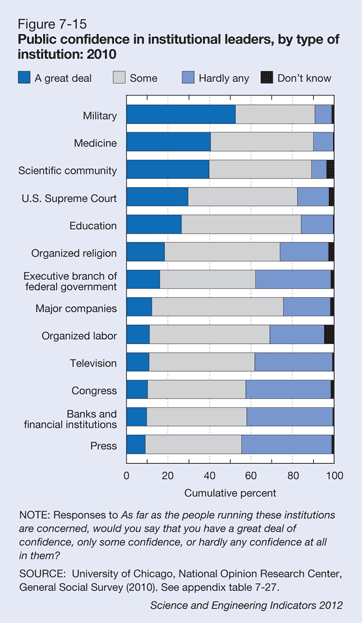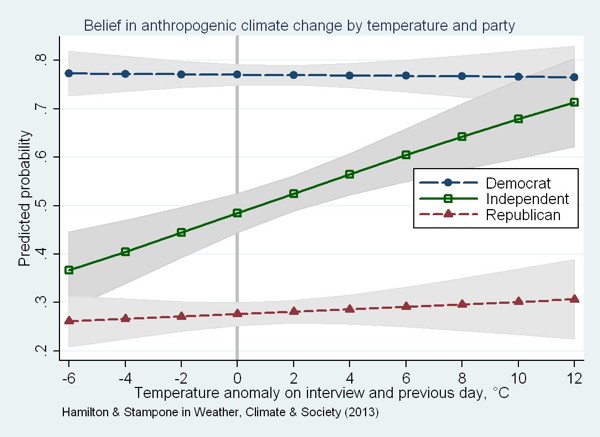Physics Today is the American Physical Society members magazine with short articles on what’s new in Physics, with a few long articles on areas in physics. Since we are about to cover communicating climate change with the public in our Osher Lifelong Learning class at UC Irvine, I wanted to summarize a few pointers from the article in Physics Today from July, 2012, p. 23-24. It has the challenging title Scientists share blame for public’s ignorance of science, and was written by David Kramer.
We start with the “trust meter” for the amount and kind of trust that the public puts in various professions:
Public trust in the dark blue and gray is as high for the Scientific Community as it is for Medicine, with 40% a great deal of trust, and another 50% with some trust.
The article also says that “a large majority of the public believes that global warming is under way. It quotes Jon Krosnik, a Stanford University social psychologist that Americans send “a pretty strong signal to lawmakers that they want something done on climate change”. Krosnik says that a survey of the media over the past 10 years have rarely quoted climate skeptics, except for Fox News. There are statements that the public does not trust scientists when they “stray into policy matters”. We know that political views are strongly held by many people.
The article interviews several science communicators for advice. Ralph Cicerone, former UCI Chancellor and now President of the National Academy of Sciences advises not to dumb things down, but to find smarter ways to convey science. Use concrete examples that the audience relates to, not abstractions (one of my many faults). John Holdren, Director of the Office of Science and Technology Policy, also says that stories relating science to peoples’ lives are much more effective than generalities.
On geoengineering, David Keith of Harvard recommends a public debate, and some small scale experiments. Of course, volcanoes also provide very dramatic short term experiments. The entire global warming of this past century was a colossal experiment releasing greenhouse gases, with a well defined set of effects.
An article Communicating the science of climate change from Physics Today, October, 2011 p. 48 by Richard C. J. Somerville and Susan Joy Hassol, contained the following survey, along with the statement that only the public in the Alarmed and Concerned catagories understood that global warming was man made:
A survey by Penn Schoen Berland, reported in PE.com, taken after the election, found that 60% of voters felt that “global warming made Hurricane Sandy worse”, despite the fact that most climate scientists will not take such a stand on any particular climate event. The poll also found that 70% of voters thought that climate change made the drought worse.
Lawrence Hamilton of the Univ. of New Hampshire, and Mary Stampone interviewed 5,000 people on climate beliefs. Those interviewed had different political preferences on climate beliefs. The authors plotted results versus current temperature anomalies. The article is “Blowin’ in the Wind: Short-Term Weather and Belief in Anthropogenic Climate Change” in the American Meteorological Society journal Weather, Climate and Society. They asked if climate change was occurring now and is primarily man made. We see about 78% of Democrats believe this, while only 28% of Republicans do. About 48% of Independents believe this on a normal day, but can be influenced by extreme deviations.
Perhaps this division by political party is because members of different parties choose different newspapers, radio, and TV news and commentary channels related to their parties. These outlets tend to slant the news according to the different parties. If this is correct, then teaching climate science to these people can influence their beliefs. One has to be ready to deal with one-liner challenges to the basic facts that you are teaching. These have been cataloged and answered by climate scientists at www.skepticalscience.com.
The question or divide among scientists and among the public about whether scientists should enter the public policy arena is something that I have heard my whole career. My hero in this is Sherry Rowland of UC Irvine, who with Mario Molina of UCI, discovered that Chlorofluorocarbons in hair sprays and refrigerants was a catalyst to eat away the earth’s ozone layer that protects us from damaging ultraviolet light from the sun. Sherry Rowland fought publicly and effectively to get an international ban on these chemicals, despite the public, and rather offensive opposition of Dow Chemicals who made the compounds. During that time the Ozone Hole over the Antarctic was discovered, showing the extreme danger of continuing on that path. He won that battle, and the earth is now much safer from that catastrophe. Rowland, Molina, and Paul Crutzen won the 1995 Nobel Prize for their work.



